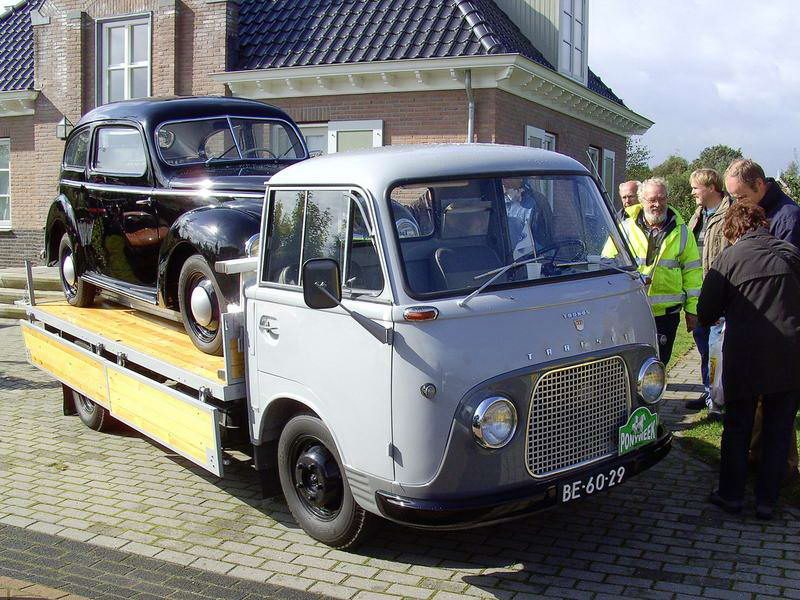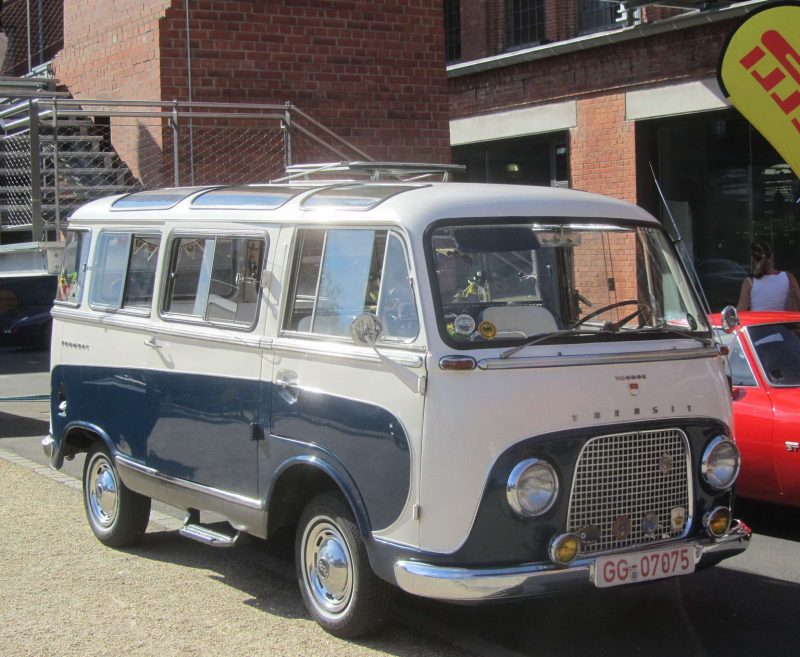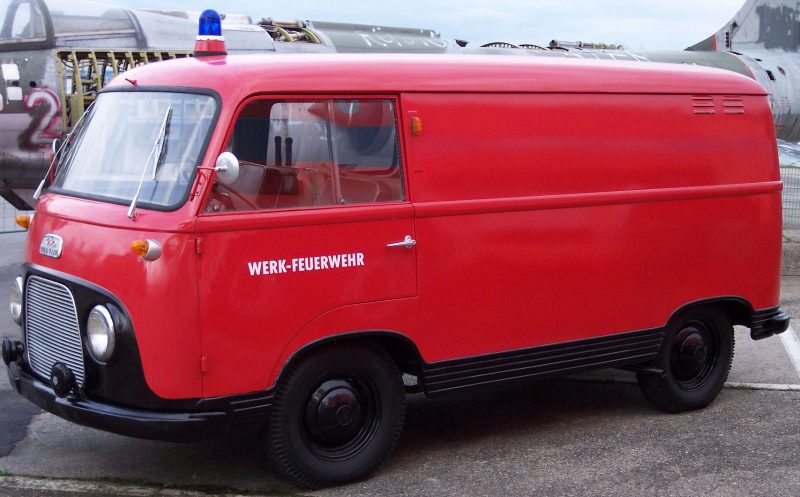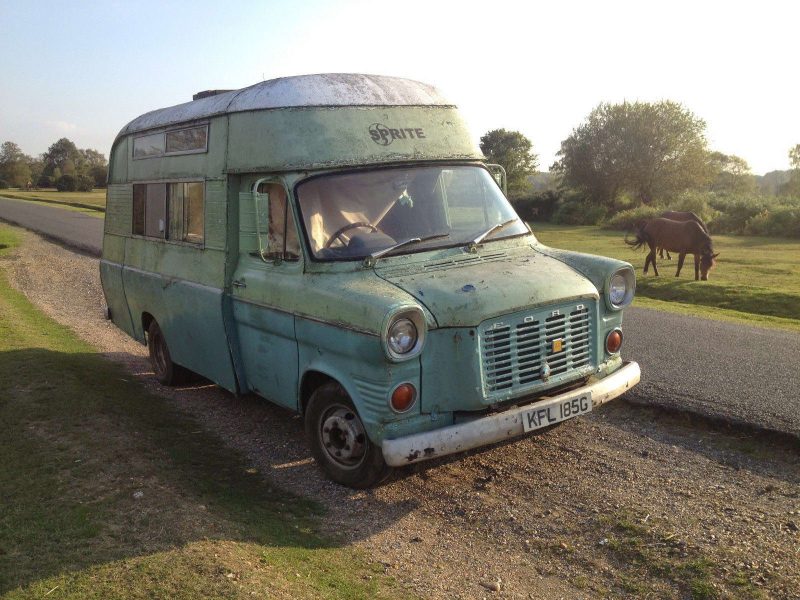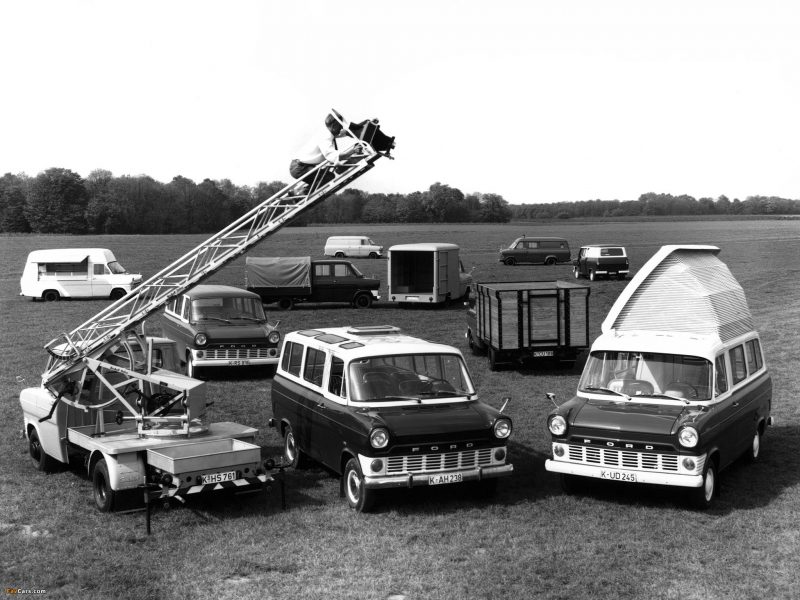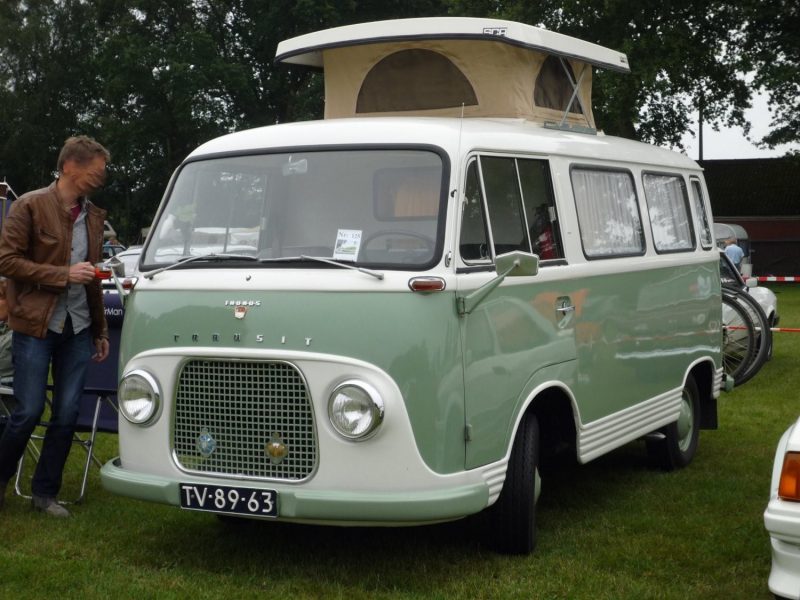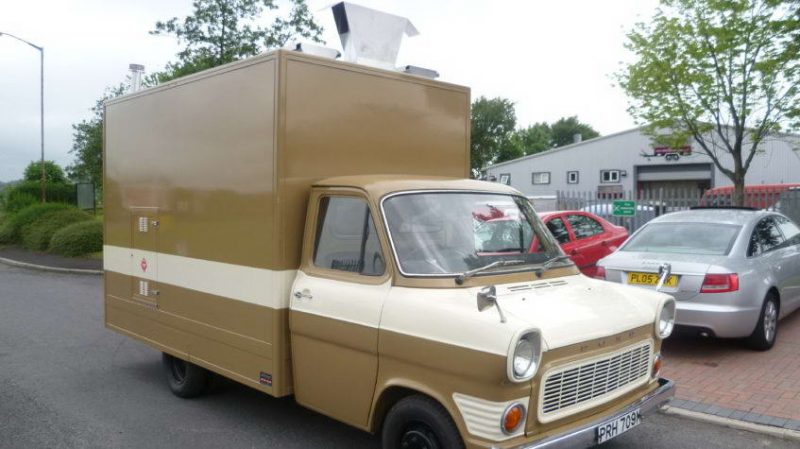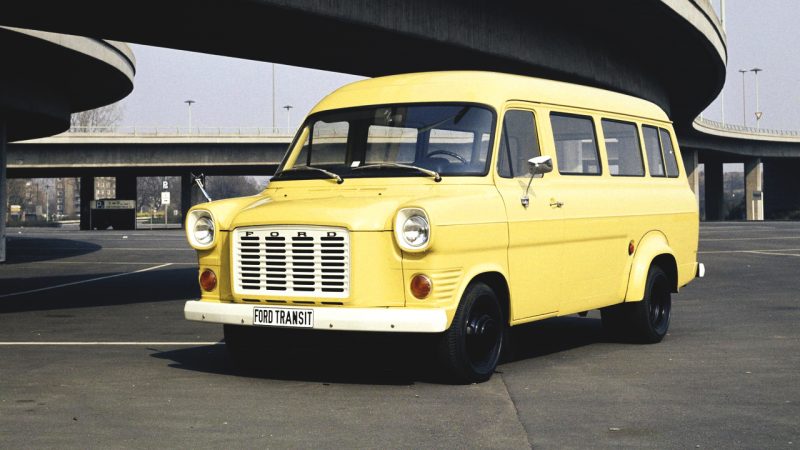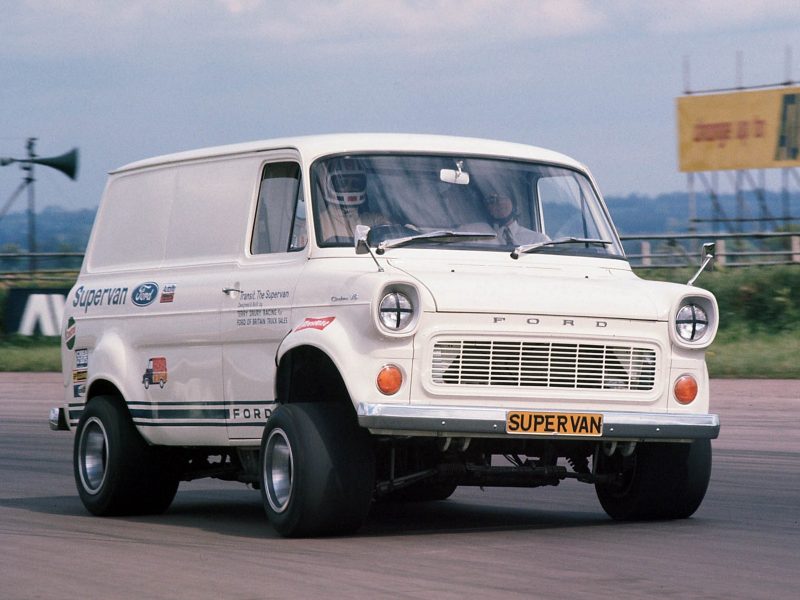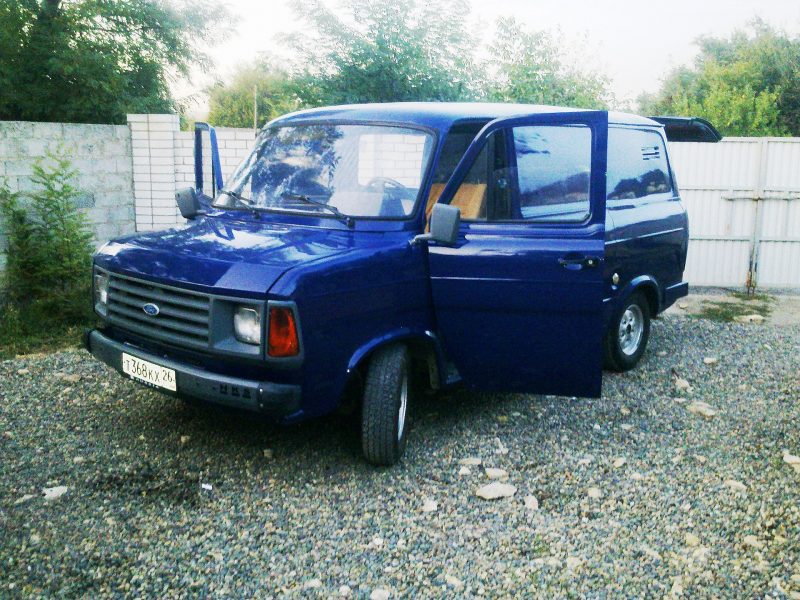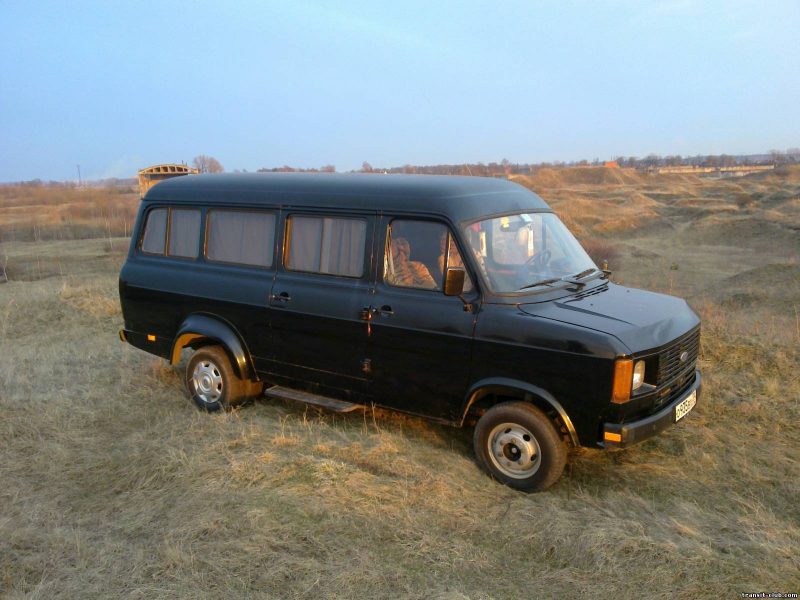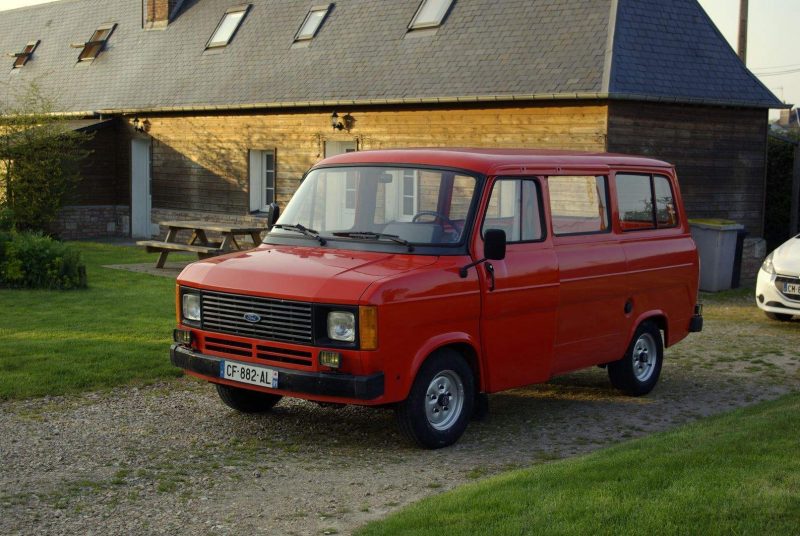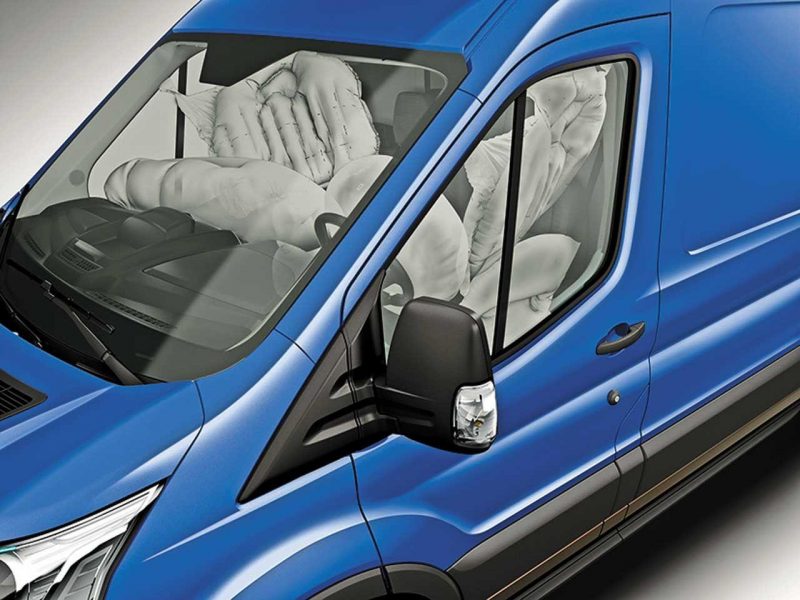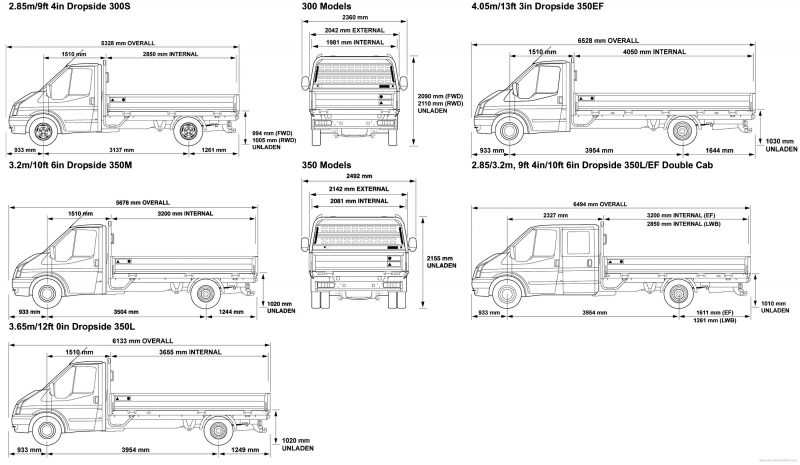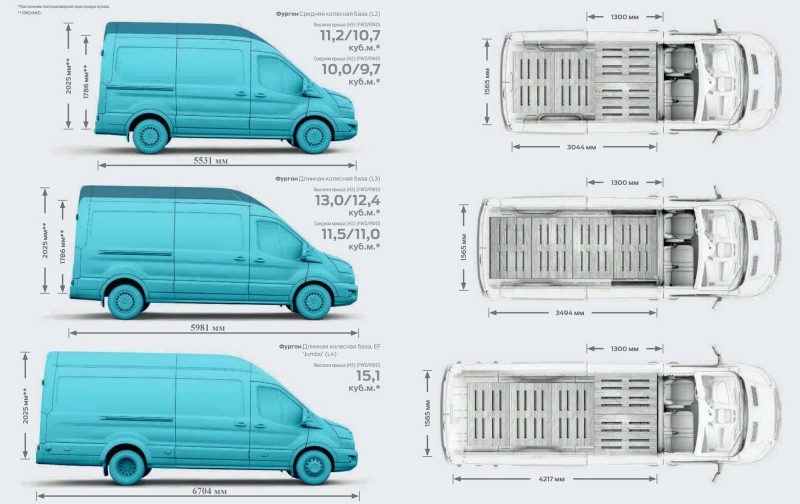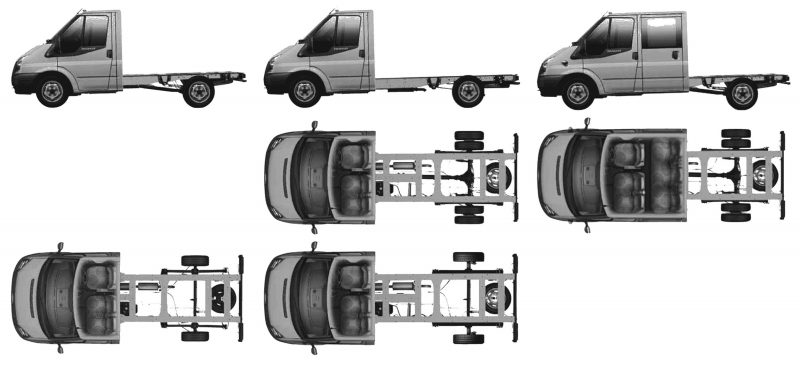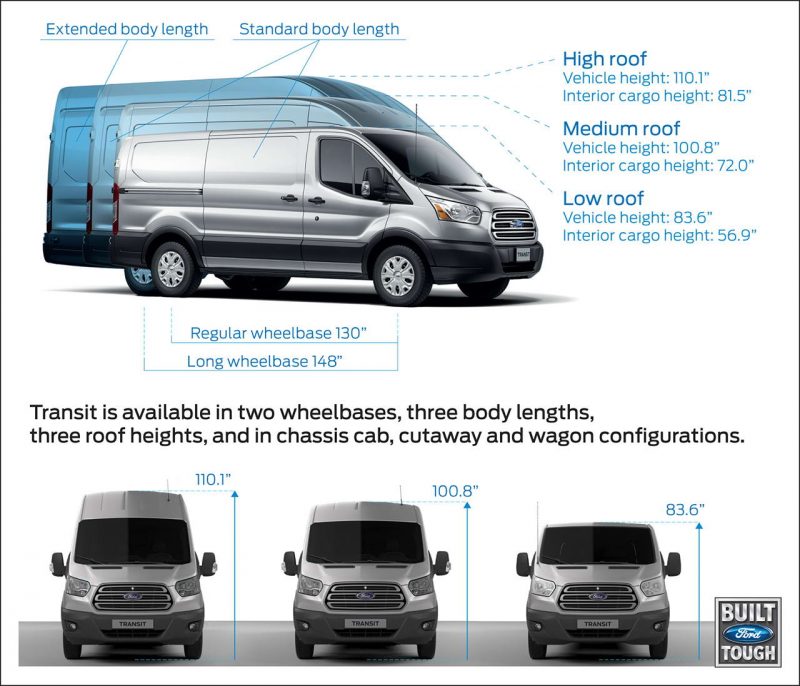Review of the legendary Ford Transit – a van that accepts various kinds

The Ford Transit is a legendary LCV class machine manufactured by an American company since the 1950s. The model includes the presence of minibuses, vans, side modifications and chassis. The car is deservedly considered one of the most comfortable and reliable in its class.
This is easy to confirm, because according to official data, the company has had huge sales, or rather, for 45 years, sold 6 300 000 vehicles. It is clear that for such a long time Transit has undergone a large number of upgrades and restylings. The car is one of the best selling minibuses in European countries. The whole model range is Ford.
Car history
Since the early 1960s, Ford’s employees have set themselves the goal – to make a comfortable, versatile car for the European car market. It is clear why there are so many different versions – there is a basic cargo version with rear-wheel drive wheels, and there are front-drive delivery vans with a lowered body floor. This includes a variety of passenger versions, and so on. Interestingly, from the very beginning Transit was called Redcap, and only in 65 before the first construction was it decided to change the name to Transit.
The arguments for this name were as follows: the internationality of the name will be clear to many buyers around the world. Since then, Ford Transit vans have been used in a variety of areas of life, including police and fire fighting vehicles, ambulances and school buses. Generally speaking, the vehicle transported a variety of goods. The Transit platform made it possible to make specialized tanks and dump trucks.
An Arab sheikh ordered a car, which was turned into a mobile bedroom with a beautiful bed. In 45 years of production, the Transit cars have been able to go a long way from an affordable, reliable and practical, but spartan working car to one of the most versatile and advanced commercial vehicles created for the consumer.
In addition, the model has been able to consistently extend the features of automotive technology in the niche of light and medium vehicles. Until the year 65, Ford had already been selling vans in European countries, which were the most important step when compared to standard vans.
A variety of European markets offered a pair of top, fundamentally independent models – British vans Thames and German FK. These vehicles appeared in the early 1950s: the German in the 53rd, and Thames in the 54th. Two variations of the van had two important qualities – practicality and versatility.
They managed to make their own contribution to the post-war European economic recovery. They were successfully used in their respective markets. In the period from 53 to 65 years, about 250,000 “trucks” produced in Germany were produced. Interestingly, it was the first time that the German truck FK was given the name Transit – since the 60th year it was renamed into Ford Taunus Transit.

Since the beginning of the 60s, there has been a clear need for vans with an increased range of options. In other words, there was a lack of increased cargo space. Because the Taunus Transit and Thames were built on the platform of standard vehicles, it was difficult to meet customer demand with the technologies already in use. In addition, during the production of the German car, the Germans came across a difficult situation. Taunus Transit was produced at a fairly busy Cologne plant.
In order to cope with the additional loads, the bodies were started to be made at the body company Drauz in Heilbronn. Each bodywork travelled a distance of 300 kilometres between Heilbronn and Cologne by water on medium sized vessels moored at the Ford landing stage on the Rhine. Ford’s management decided to replace these two vans by designing a completely new family of vans that would satisfy the needs of all European markets, leaving the production of models in England and Germany.
The initial stage of the design, which was named Redcap, was started by the design department. Ed Baumgartner, an engineer of American descent, led this department. Experience in operating cars with carriages and front end control produced in Germany and England proved to the design team that the power unit of the newest car should be placed under a small hood, behind the transverse partition. Such a plan allowed to reduce the noise level and did not “steal” useful space inside. All thoughts were transferred to sketches, and later they were embodied in a three-dimensional model produced by the design staff of the American group Ford.
The finished model was delivered by ship to England, where it could be modified with the use of additional European standards. For example, the headlights were raised and the front grille was made more similar to the truck grille. Until the beginning of the 63rd year, a group of planning specialists summed up the results of the sketch design, were able to determine the price, decide on the construction of the new product and handed it to the developers.
The terms of reference, which were prepared by designers, provided for the production of a reliable, comfortable, economical, and also simple and cheap in maintenance machine, the capacity of which was from 610 to 1,780 kilograms. The development was undertaken by a group of specialists, which was located in South Oakendon (England).
Durability of the car was tested at the Ford range in Boreham (UK), which was not intended for long-distance high-speed driving – such tests were conducted on ordinary road sections. The transit could have entered the English market under the name of V-series, if not for one “but”. Bill Betty, who was chairman of Ford’s England office, decided to intervene. Even before he showed the car at the presentation, Bill expressed his desire to see the last pilot.
The situation was such that a left-hand vehicle made for a German country was brought to his office by Ford. Bill took up the idea at the same time and used it to show it in Germany. The debut version of Transit left the Ford assembly shop in August (9th day) 1965. It happened in the English city of Langley. The first Transit models had 1.7-liter gasoline engines with a power of 74 horsepower. There were also 2.0-liter engines producing 86 “horses”.
The first diesel engine was called Perkins 4/99, it developed 44 horsepower. Ford Transit was constantly created as a combination of two fundamentally similar models. At the start of production (in 1965) were created versions with a short wheelbase, which received the name LCX, and with a large LCY – a version with a double tires rear axle.
Each of the modifications was in three versions in terms of payload – short wheelbase trucks carried 610, 865 and 1,120 kilograms. Massive models with a long wheelbase had a payload of 1,272, 1,527 and 1,782 kilograms. The Ford Transit cargo came with standard swing or hinged rear doors and had a separate side door for loading. If desired, the version without side door was ordered.
After a while, the Ford Transit was distinguished by its reliability – for this reason, the trucks were and are so popular in the power structures, fire services, ambulance, rescue services and security services. Thanks to Ford Transit’s good reputation as a lightning-fast passenger transporter, the entire Transit fleet of buses, after a few months of production, operates the world’s highest-altitude passenger route, the Andes Passes of the Peruvian Andes, where the height is more than 4,000 meters.
By 1971, some changes had been made to the appearance of the “bus” – a new grille had found its place, which allowed the model to be more like a passenger car. A little later, the Ford Transit Supervan was introduced. It was built on the platform of a Ford GT 40 sports car, so it had a V-shaped 5.0-liter 8-valve engine, which allowed the vehicle to reach a speed of 240 km/h.
A year later, Ford produces its own debut high-speed diesel-powered engine – York. Models with short wheelbase were equipped with 55 hp engine, and heavier models with long wheelbase were equipped with 62 hp unit.
1975 brought a new upgrade to Ford Transit. The novelty is easier to recognize with the help of a new functional exterior – radiator grilles, bumpers, windshield cladding and mirrors. Interestingly enough, all this was painted black.
In the interior of the pedals decided to move forward, and the chair – back. This solution made it possible to add 100 millimeters of free space in the legs, and the steering column was slightly lengthened to facilitate driving.
Interesting that the Transit was the first car of this class, which installed disc brakes with an amplifier.
Short wheelbase vehicles were able to get such an innovation by the year 75, with a long wheelbase version a year later. The heaviest in the range of minibuses was named Transit 190 (1976). This model could transport loads weighing 3.5 tons. For the first time, medium class production vehicles had ventilated disc brakes installed.
The first clear change in the appearance of the Transit truck took place in March 78. This year the production of cars with the newest appearance started. Instead of a stumpy cut-off hood, a new, elongated and streamlined hood was installed, under which there were the latest power units running on gasoline and diesel fuel.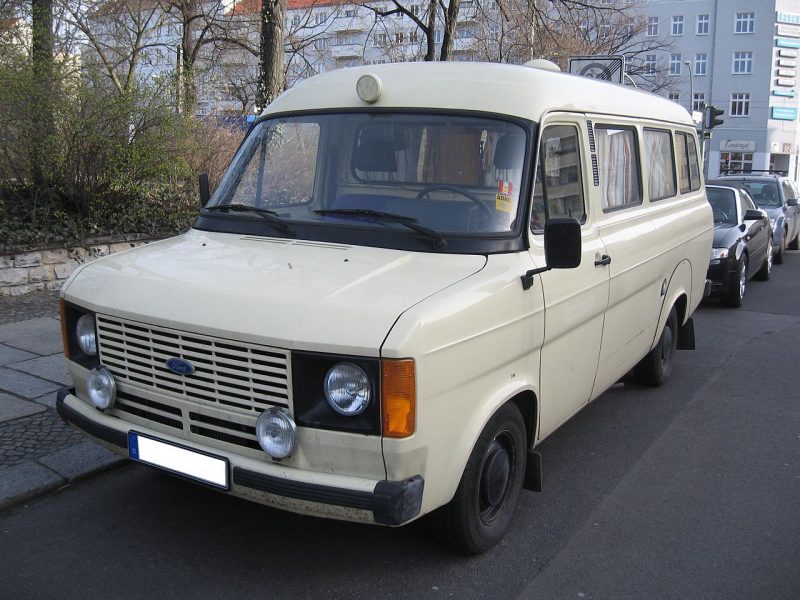
With the advent of 1984 came the DI engine, which became a revolution. It had a capacity of 2.5-liter, high pressure rotary fuel pump and worked on diesel fuel. The novelty developed not 62, but 68 horsepower and reduced fuel consumption by 24 percent for short wheelbase versions and by 20 percent for long wheelbase vehicles.
Since January 85, twenty years later, when the debut model was released, motorists have seen a fundamentally new model range of the popular company. Principally new model showed the best index of drag coefficient (0.37). This indicator was better than the majority of cars of those years. It is unusual that with the increased volume of the cargo area by 11 – 13.5 percent, the Cda data decreased by 11 percent, and this, in turn, made it possible to reduce fuel consumption by 8%.
The designers developed extended doors with wide windows, which created a feeling of increased volume in the cabin. With the help of the wider and higher-quality aft doors, access to the luggage compartment has been made easier, and pallets of 1m width are now loaded into the luggage compartment.
In addition, there is an improved independent suspension such as McPherson, rack and pinion steering in short wheelbase versions and improved security locks for doors and ignition systems. As a result, the overall safety standards of the machine have been improved.
When 1991 came, the model again took initial steps to upgrade the bodywork. Thanks to this, it was possible to improve the efficiency of the production itself, which had a positive impact on the quality of the vehicle, as well as new models withstood crash tests at a speed of 48 kilometers per hour.
By using the latest design, it was possible to install seats for three people inside the machine. The novelty became popular, partly because of the diesel engine, which has a turbocharger. It was a 2.5-liter DI engine, which used electronic control for the first time (for the middle class), which allowed increasing the engine power up to 100 horsepower.
The engine met more stringent environmental standards. To the standard version of the engine (70 “horses”) was added a novelty – “atmospheric”, running on diesel fuel DI. It was a 2.5-liter 80 hp engine. The vehicle could be easily distinguished among other vehicles. This is partly due to the friendly, oval-shaped radiator grille. The standard Transit version was the most excellent and safe Transit machine in the history of the brand.
After 35 years (in 2000) a new family of Ford Transit trucks was released. The model was officially presented at the Amsterdam RAI 2000 exhibition, and produced at the Belgian assembly plant Ford in Genk. The car was distinguished by the fact that it had the industry’s first model program, which included front and rear drive modifications, assembled on a single base.
Then the van was able to win a large number of prizes at national European competitions. It will not be superfluous to notice that the model has regained a leading position in European countries in the rank of commercial vehicles of the middle class, produced in series.
European motorists bought 163,656 units in 2001, which broke the company’s own record by 5,000 units (the record was as of 1998). After two years of production of Transit’s front-wheel drive units, they were already part of about 50 percent of the total volume of vehicles sold.
Amsterdam’s RAI 2002 showcased the Transit Jumbo, which had a payload of 4.25 tonnes and a two-axle rear axle tire. After the successful 3.5-ton Jumbo production in 2001, the 4.25-ton version presented the best combination of payload and luggage location for the Transit customers. In addition, there was a place for an excellent level of safety, the best in the field of application. The same year allowed consumers to check the availability of the new Ford turbocharged diesel engine, which had Common Rail technology, the Duratorq TDCi. It improved performance and saved fuel, and also reduced noise and exhaust emissions.
Initially, the engine was presented in a 2.0-liter version, which allowed to develop 125 horsepower. It was the second generation, installed on front-drive versions and had the direct injection technology described above. When 2004 came, the Ford Transit was moved from Genk to Cochaeli, where Ford Otosan’s state-of-the-art facility was located. In the future, European Transit options will only be produced in Southampton and Cochaeli.
A couple of years later, Ford Transit of the last family began producing. The previous version was subject to various changes – the appearance became fresh. A new cabin was installed, where there was a gear lever on the dashboard (also called a joystick), significantly increased comfort and expanded the range of available options.

All new implementations of the Transit modular program in 2006 were supplemented in 2007 by the availability of an intelligent all-wheel drive system. It turns out that the famous van became the only vehicle assembled on a single base and presented with modifications with front, rear and all-wheel drive.
All cars produced after 2007 were equipped with an original nameplate, which reminded of the title of “International Van of the Year 2007”. Therefore, the novelty was still recognized, and it received new awards. Two years later (in 2009), the passenger minibus was the first commercial vehicle in the Ford division to meet Euro-5 environmental standards.
Looks like Transit 2014
The new look of the car makes you look at yourself. It is distracted by the presence of reinforced parts and very “looks” like a car made in the U.S., the same class, which is not surprising in principle. Because the new Transit is a global project, the car is intended for sale on all continents.
Full-scale production was launched not only in Turkey, but also in the United States of America. And later, the car will be produced in the Russian Federation, in the city of Yelabuga. The new Ford Transit has galvanized steps, wheel arcs and power bars.
With such a simple move, the company decided to immediately “insure” against corrosion resistance for 12 years. In addition, in pursuit of increased comfort, this version has been improved in terms of noise isolation. The body component of the Ford is almost the same as the passenger version.
It is practical and strong, but still has a lot of complaints from its owners. The metal used for it is quite weak. Despite the high quality of the coating, corrosion can occur after 4 years of active use of the machine. In general, the car looks stylish.
There are slanting headlamps that can be perfectly combined with large-size radiator grilles, which are designed in accordance with the company’s philosophy. The front bumper is voluminous and made of several elements, which allowed to reduce the cost during the damage. Lighting equipment was placed closer to the windshield.
Wide overlays allowed additional protection of the sidewalls. The machine is able to easily withstand frost and harsh “our” conditions, but it is quite rigid, which is due to the structure of the suspension. The appearance of the model has evolved with a new philosophy. The machine was designed in accordance with the New Edge style.
Interior
The salon of the new Ford Transit minibus has been completely changed. The interior has a new dashboard, dashboard and multifunctional steering wheel. Improved equipment Trend, has a leather steering wheel and selector gearbox, radio with CD and voice control Ford SYNC. The driver’s seat has an adjustable lumbar support.
In addition, all seat settings are electrically powered as a separate option. The cabin has an abundance of clothing compartments, which includes a “secret” glove compartment, located above the dashboard visor. The dashboard itself is well readable. On top of the dashboard there is a visor, which serves as a mini glove compartment lid.
Special attention was paid to the transformation of passenger seats. The cushion on the right side of the seat can be tilted forwards, allowing for a large enough amount of luggage to be placed underneath. The backrest of the middle seat can be partially folded together to form a comfortable table. The central console is slightly overloaded with various buttons. In general, the interior of Ford Transit was made in the style of Ford cars. Two variations of the interior of the car provide the possibility to install either 2 separate seats or a driver’s seat and a 2-seater sofa. The interior is very spacious and cozy, and the presence of a flat floor, just can not leave indifferent.
Due to the high planting level, this provides excellent visibility. With the help of enlarged mirrors and a massive display, which is attached on top of the internal body mirror, and which displays the image from the rear view camera, maneuverability characteristics are increased several times and it is much easier to drive the vehicle.
Speaking for the cargo area, it has a useful volume of up to 15.1 cubic meters. The “Trend” version has a floor, equipped with a protective plastic coating. It is nice that all cars are already in basic version with the option of heating the windshield, which is very comfortable, given the cold winters in our country. There is no need to clean the glass from snow and ice, but it is not as easy as in a car.
Specifications
Mower unit
The last family of Ford Transit comes with diesel and gasoline engines. In European countries, as well as in the Russian Federation, such units are installed:
- Duratorq TDCi l4 2.2 litre diesel engine. This variation of the engine is the most common. The Russian market assumes installation of such an engine on all versions. The power unit meets Euro-4 environmental standards. The power can be different: from 100 to 155 horsepower. Among the distinctive features is the Auto-Start-Stop function, which starts and stops the engine, depending on the specific conditions on the road. The system also allows you to save a lot of money on fuel. A large number of diesel engines have a speed limiter set at 100 kilometres per hour. There is a possibility to refuse such a function.
- Duratorq TDCi l4 engine with a capacity of 2.4 liters and running on diesel fuel. It has a similar design to the above model, but has a high power. On the territory of the Russian Federation, such a model is not so easy to see.
- Duratorq TDCi diesel engine with a capacity of 3.2 litres. It is considered to be the top version, as it allows to develop 200 horsepower.
- Duratec l4 engine, already running on gasoline and having a volume of 2.3 liters. The model is not as common as the diesel range.
Today, Ford uses motors developed together with PSA specialists. The engines have a small mass and high reliability. All power units possess small indicators of emission of harmful substances and “modestly” consume fuel. Thanks to the system of energy recovery and battery charge management, it was possible to increase the efficiency of such elements.
Interestingly, the machine has been used a range of advanced features that can disable some of the nodes when they are not needed. This has resulted in significant fuel savings.
For example, a battery regulator, monitors the condition of the battery every hour. If the charging level is around 80 percent, the alternator switches off automatically, but the battery is charged with a regenerative device that uses energy that is out of braking force and during inertial movement.
The situation is a bit similar to that of an oil pump, which only inflates the oil when it is necessary. The fuel tank has a capacity of 80 litres, but as a separate option, a 103 litre tank can be installed. Since the model has a low average fuel consumption, a full tank filling will last for 10 hours. In the city, the engine “eats” about 10 liters per 100 km. On the track, this figure is 7.8 liters, and in a mixed cycle – 8.8 liters for every 100 kilometers.
Transmission
The Russian market offers a choice of 5 and 6-speed manual gearboxes. The nature of the transmission operation is similar to the work of the famous “Gazelle”, but the foreign installation moves softer. All speeds have received the presence of synchronizers, and the last speed – increasing. The switching device works perfectly, it is not necessary to put the big efforts.
The 1st speed is very short, the 2nd speed is very “pushed back”. With this, the loaded Ford Transit is lifted at a speed of 5 km/h for climbing. Work of a box, is as much as possible approached to work of a box of the car Mondeo, therefore transfers are switched in a correct mode, and the lever goes limited. The latest models come with only 6-speed gearbox Durashift, which is distinguished by a long service life.
Suspension
Ford Transit has a half-bonneted layout scheme with the formula of 4×2 wheels. The power unit is located longitudinally and in front. The driving wheels are rear wheels. Paying attention to the technical features and year of production of “Transit”, the model was equipped with different variations of “walk” and suspension. The most common:
- Presence of a front spring independent suspension with shock absorbers and a stabilizer of lateral stability (there are variants and without it).
- Rear dependent suspension on longitudinal semi-elliptic springs. Its design still has a stabilizer of lateral stability (there are variants and without it) and telescopic hydraulic shock absorbers.
Rear dependent suspension on longitudinal semi-elliptic springs
Rule control
The rack and pinion steering unit has an integrated hydraulic booster. Hinges are located at the ends of the rail to the supports. With this, the steering rods are very short. The angle of rotation is not so big and the number of revolutions of the steering wheel is 3.3 (which is clearly less than that of competitors).
Brake system
Previously, Ford Transit had disc and drum brakes. The latest generations of machines already use only disc brakes on all wheels. The operating brake system is of hydraulic type, double-circuit and has a vacuum booster, electronic force distribution and diagonal separation into circuits.
The basic equipment is equipped with ABS system. Auxiliary braking devices – each circuit of the operating system with mechanical drive to the brakes. The steering wheel on steep corners seems tight, because the car is not a passenger car.
Safety
It is not for nothing that Transit is considered to be one of the safest vehicles of the class – M. There are systems of assistance at the start of the movement, airbags, three-point safety belts, ISOFIX child seats on passenger seats, BTCS functions that provide control of the brake system and traction control and course stability system.
Standard accessories include Traction Control, Emergency Brake Assist and more. A list of innovative solutions has been applied. For example, the Curve Control system is able to brake the wheels when the car leaves the trajectory of the turn. The Roll-Over Mitigation service is able to recognize possible threats in advance and activate the ESC service to increase stability on the road.
Load Adaptive Control is able to coordinate the operation of the ESC while the vehicle is loaded. The Hill Start Assist system prevents the machine from rolling back to the mountain during the start. On top of that, the Lane Keeping Alert system is also available to drive in a given lane. If the road train leaves the trajectory, the Trailer Sway Control service is activated, which is able to brake the car.
Chauffeur and passenger safety is the most important purpose of the automobile construction. Although past generations of Transit have been safe, the development department has strengthened its reputation by improving safety systems.
Special attention was paid to the design of the front of the machine. Using new computer-aided design systems, the Transit development department was able to modify the front and side boxes to adjust their deformation during the impact. This innovation allowed to further reduce the area of the front part, which is damaged by impacts at low speed. During such accidents, there is one additional advantage – often, to repair the machine, there is no need to remove the engine and gearbox, which in turn reduces the time and cost of repair.
This structural change and increased transverse body strength in the front panel area have reduced cabin deformation and improved the safety of the driver and the passenger sitting next to him. In addition, they introduced a stronger driver’s seat support. The company decided to install an airbag for the chauffeur already in the basic configuration on all versions. The optional 120-litre passenger airbag was doubled when compared to the previous model.
Now it can provide good protection for two sitting people. They started to use side AirBags for the car as a separate option to protect the head and chest. If you order leather upholstery, the side AirBags come in the base. On the newest models, additional inflatable “curtains” are installed on the windows.
Price and equipment
For Russian motorists, only the Ford Transit model with 2.2-liter Duratorq diesel engines is available. Basic equipment is severely limited. Almost everything is offered as an additional option. The minimum equipment of the car costs from 1,900,000 rubles. Version of Jumbo (with an extended base), is estimated from 33704 $.
Buying a variant on the secondary market can be quite easy, because there are enough ads for sale. Unusually, but you can find ads to sell models of 1984-1985 year. Of course, everyone understands what the acquisition is, a very dubious idea. Cars of 2006-2009 years, with normal condition, will be estimated from 4596 $, versions younger, 2012-2015 years, already cost from 8732 $.
Owner’s Reviews
Many car owners note the good quality of the engine, for example up to 410,000 kilometers, the engine did not cause any problems. Only consumables such as oil and air filters are replaced. Most people praise the front suspension, which is “hard to kill”. Despite the quality of the body, some complain about it, as it rusts faster than its peers of other manufacturers.
The model is easy to use, cheap to maintain and repair. Drivers note a pleasant salon, even in the back of the van – you sit as if in a car, which cannot be said about “classmates”. Maneuverability of the car is at the height. The power unit is not fastidious to “Russian solarka”.
Ford is very reliable, dynamic and passable. Motorists do not like the rear suspension, which has short springs. This is a strong “jumpiness”, you feel discomfort among the passengers sitting behind. Noise isolation suffers greatly, and the lighting is far from perfect.
Despite the rather good equipment, many people still make tuning Ford Transit, which only adds to the pleasant sensations. However, too much tuning, especially external one, makes the car ugly, so you need to be careful in this matter.
Pluses and minuses
Pluses cars
- Pleasant and stylish appearance, especially in the latest generation;
- Modernized front optics;
- Interesting body design;
- The last update allowed you to choose the drive;
- Even variants with all-wheel drive system;
- Modernized power units;
- Large number of machine modifications
- Diverse electronic systems and assistants to help the driver drive the car;
- The latest generation provides improved safety (there are front, side airbags and air curtains);
- Because the interior of the minibus is more pleasant and stylish;
- Qualitative bodywork;
- Slight fuel consumption;
- Van version, allows you to transport a variety of goods, which is perfect for private drivers;
- Presents a color screen on the center console, where you can display images from the rear camera;
- One manageability;
- Rigid suspension;
- Appceptable ground clearance height;
- There is an energy recovery system;
- Heavy-duty motors;
- Confirmed transmission;
- New convenient dashboard;
- In the salon there are many compartments for various trifles;
- Ergonomic salon;
- Higher payload;
- It’s a hydraulic power steering.
Cons of a car
- Never the quality of the bodywork, it can sometimes be problematic;
- The central console, which is heavily loaded with buttons;
- Soundproofing suffers
- Thickle steering wheel during manoeuvring;
- Poor basic equipment of the car, the most necessary options should be bought separately.
We sum up
Throughout its history, Ford Transit has always been famous among drivers and was in great demand. Of course, much has changed since the introduction of the first models, but reliability, economy, versatility and efficiency have passed from generation to generation, reaching the last family. Today, the passenger and cargo vehicle has the most modern, technologically advanced and economical power units.
It is clear that the racing properties do not need to wait for such an engine, so it copes well with its direct tasks. It is very pleasant that designers have changed the interior and appearance of the “truck” for the better, which allows it to compete successfully with its competitors.
Experts have not forgotten about the high level of safety, having equipped the model with front and side airbags, as well as inflatable curtains. Electronic stuffing has become even richer, with an abundance of various auxiliary systems in its arsenal. Despite the fact that the latest generation is now a bit like the “American” style, which is controversial, many drivers will appreciate the confident step of Ford to maintain its position in the automotive market.
We advise you to read the article: Ford History


